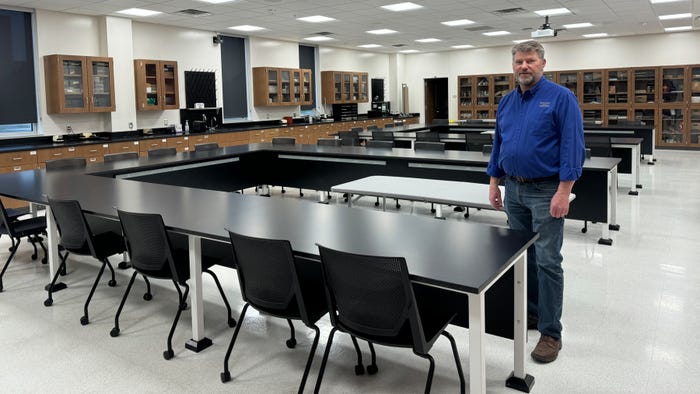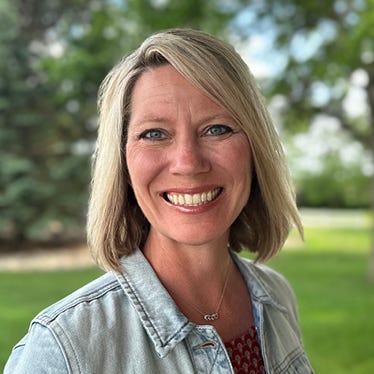May 10, 2024

CLASS IN SESSION: Brent Turnipseed stands in a classroom of the new Raven Precision Agriculture Center at South Dakota State University. The new building brings agronomy and agricultural engineering disciplines under one roof, where students and faculty can collaborate, conduct research and innovate. Photos by Holly Wortmann
“I didn’t plan to be here this long,” chuckles Dr. Brent Turnipseed, South Dakota State University’s seed-testing laboratory manager. “I studied agronomy — specifically, seed science and technology — at Mississippi State University. In those days, they were the world's best for seed research and training. It gave me an all-around background, from understanding harvesting, drying, storage and conditioning/cleaning of seeds to testing and labeling.”
After graduation, Turnipseed headed north to SDSU. “I traveled to Brookings in early May 1990 for an interview and was offered the job two days after returning to Mississippi. I arrived in South Dakota on Dec. 31, 1990, for my new job. I got out of the truck, and it was 10 [degrees F] below zero with [a] 30-below wind chill.”
And it's a good thing he stayed. Turnipseed’s 33 years in leadership at SDSU contributed to the building of a new seed-testing lab in 2009, innovations in technology and a copious number of students contributing to the world of seed science.
“I had a lot to learn when I arrived at SDSU, as we were testing many crops that I didn’t have a background with,” Turnipseed says. “I was only the second Ph.D. to run the lab, and working with the region's farmers and seed companies has been extremely rewarding.”
Life at the lab
Turnipseed explains that the crew at the lab is one of the best, and the work they conduct is consistently accurate. “You couldn’t ask for a better bunch of people to work with,” he says. “We’re known for testing specialties in certain areas — cereals, alfalfa, native grasses, wildflowers and varietal identification in cereals. We can offer consistency and an accurate response if you want it tested right.”
For more than 60 years, the SDSU seed-testing lab has hired students as part-time analysts and trained them in the science and art of seed testing. “It is always a pleasure to train students who develop the skills and background for seed testing if they choose to go that career route,” Turnipseed says. “These are sharp, young people. Some are going on to get their registered seed technologist status through the Society of Commercial Seed Technologists.”
In addition to overseeing the management of the seed lab, Turnipseed is SDSU’s assistant department head of agronomy, horticulture and plant science. He teaches four college courses and is the coach for SDSU’s collegiate crop-judging team.
“Part of my contribution has been to marry the seed testing to the classes I teach at the university so there is real work learning and training in my courses,” Turnipseed says. “I love teaching. The students I’ve had, by and large, have been great to work with. Some have gone a long way.”
Seed testing methods
Through the years, SDSU’s seed lab has invested in the advanced equipment necessary to perform tests. Yet, the basic testing methods haven’t changed. Three tests are required for the sale of seed in South Dakota: a purity analysis, a noxious weed seed exam and a germination test.
Samples start with the lab’s secretary for login, then go out to the dividing area. Since the seed segregates and settles in the package, it must be remixed using dividers. The seed then goes to the purity/noxious-testing area.
After the seed gets cleaned, everything is pure seed units and ready for the next step: germination and viability testing. The germination test determines the percentage of normal seedlings that develop under ideal growing conditions.
“We follow the Association of Official Seed Analysts (AOSA) rules for testing seeds,” Turnipseed says. “Seed testing in this country is supposed to be conducted according to these rules or the Federal Seed Act regulations, which pretty much mirror the AOSA rules.”
He says that following the rules is integral to research success. “When a species received for testing is not in the rules, you still have guidelines about how to conduct testing,” Turnipseed says. “When the labs choose not to follow the rules they are required to follow, results can be quite inaccurate and nonrepeatable. The rules are there to promote uniformity in testing and create a level playing ground.
“We’ll give you an honest result. We serve people, and they know that if they send it here, we will call it like it is. We give it the best shot we can to help it germinate, and the rules provide guidelines and drawings of abnormal seedlings, which do not produce plants in the field. If you have noxious weeds, we’re going to tell you.”
Changes in the industry
“Since I started, herbicide traits and Bt traits have come along,” Turnipseed says. “The industry keeps pushing for more rapid turnaround and forgets testing takes time to do it right. There have been tremendous changes on the DNA-testing side, and it has changed the variety of testing methods for crops like corn, soybeans and other specific crops.
“Another thing that has changed is we are no longer doing electrophoresis testing for varietal identification. Seven years ago, we invested in the high-performance liquid chromatography (HPLC) equipment with the help of the South Dakota Crop Improvement Association.”
HPLC is a chemical separation technique that can separate alcohol-soluble proteins and other compounds, primarily in cereal crops. The instrument provides a "fingerprint pattern" for each variety of seed. A known check sample of the variety in question is processed and overlaid with the client's sample for comparison and confirmation of the variety.
Using this technique for varietal verification/ID is fast and economical. Turnipseed says this method is a lot safer and more efficient than electrophoresis.
“Before, it would occupy an entire day. Now, we can run up to 60 samples in one shot, taking 18 minutes for each sample, and it’s fully automated,” he says. “We can identify if a seed sample is the variety a seedsman claims it is. In the past, before they did this, they’d have to take samples to grow out the next summer and then find out a year later that it's the wrong variety.”
“Future research will continue vigor testing to better identify seed lots and their risk for emergence,” Turnipseed says of the future. “More research will be conducted into biologicals and their impact on germination/vigor/yield. Fungicides and insecticides are other technologies that continue to evolve. Their use will continue to increase as growers see the benefits of seed treatment.”
Turnipseed’s contributions at SDSU are a legacy. The seed-testing lab has remained the trusted third-party lab for accurate test results under his direction. After 33 years, it’s time to celebrate his retirement. But unlike his youthful ploy to not stay in South Dakota long, Turnipseed will continue to be a familiar face to students, colleagues and clients at the university.
“I hope to come back in six months to teach my classes or offer any extra help in the lab,” he says. “I thoroughly enjoy teaching courses and working with students. But now, I’m looking forward to more travel, gardening, fishing, hunting, woodworking and reading for fun.”
For information on the SDSU seed-testing lab and for a complete list of testing services, visit sdstate.edu/agronomy-horticulture-and-plant-science/sdsu-seed-testing-lab.
University connection
The SDSU seed-testing lab holds a unique opportunity with its connection to the university. The crucial components of the lab are teaching, training and research.
The lab aims to provide accurate, rapid, unbiased seed testing to anyone. “We are self-supporting,” Turnipseed says. “When we have good years, we pump money back into better equipment and research. We advise clients to obtain only the testing they need, as the money doesn’t line our pockets. I’ve seen a lot of tests recommended to seed growers that they don’t necessarily need, and we’re going to be honest with farmers and companies.”
About 200 different species come through SDSU’s seed lab for testing each year. It’s unique to other labs in that the university gets a variety of species for testing, including seeds of agricultural crops, grasses, flowers, trees and vegetables.
Seed testing provides the needed information for determining the value of the seed. Testing seed gives the client a wide understanding of a seed lot's germination potential and possible weed contamination. By knowing the results of the tests, individuals can evaluate the potential of a seed lot before planting to ensure a maximum yield.
“Routinely, we have 13 different states that will send us samples,” Turnipseed says. “For example, we’ll see wheat and mostly sunflowers from Texas. From Maine, it's primarily cereals, mainly oats. This year, we’ll test between 3,000 and 4,000 seed samples. Some years, there's another 4,000 research samples that will go through. We have to keep a [reference] sample of everything we test for a year.”
The lab started out as a Department of Agriculture lab and was moved to the SDSU campus in the 1930s. Today’s lab is housed in the Young Brothers Seed Technology Laboratory on the Innovation Campus at SDSU. It is the official state lab for regulatory testing and a U.S. Department of Agriculture-accredited seed lab. The lab employs three full-time employees.
“I’ve got one of the best teams I’ve ever had at present,” Turnipseed says. “We have a full-time assistant manager, Kathy Mathiason, who oversees the day-to-day operation. I also have a germination/viability testing supervisor, Hannah Gillen, who oversees that area of the lab, running germination/tetrazolium/vigor/herbicide trait testing. She is a former student employee. We also have a full-time secretary, Julie Sperlich, who takes care of contacting clients, entering samples, test results and billing.”
About the Author(s)
You May Also Like






